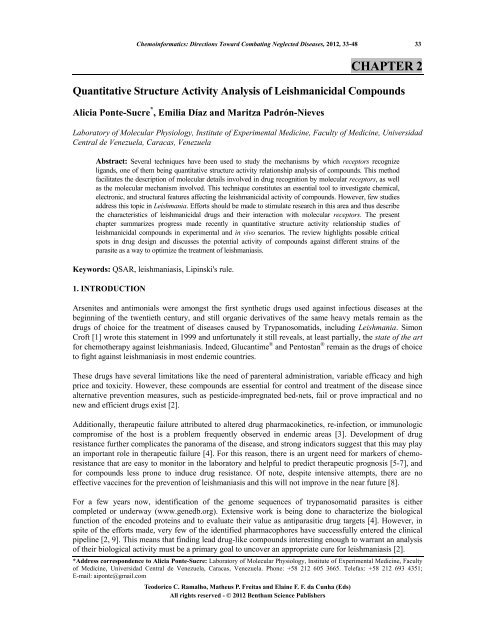chapter 1 - Bentham Science
chapter 1 - Bentham Science
chapter 1 - Bentham Science
You also want an ePaper? Increase the reach of your titles
YUMPU automatically turns print PDFs into web optimized ePapers that Google loves.
Chemoinformatics: Directions Toward Combating Neglected Diseases, 2012, 33-48 33<br />
Teodorico C. Ramalho, Matheus P. Freitas and Elaine F. F. da Cunha (Eds)<br />
All rights reserved - © 2012 <strong>Bentham</strong> <strong>Science</strong> Publishers<br />
CHAPTER 2<br />
Quantitative Structure Activity Analysis of Leishmanicidal Compounds<br />
Alicia Ponte-Sucre * , Emilia Díaz and Maritza Padrón-Nieves<br />
Laboratory of Molecular Physiology, Institute of Experimental Medicine, Faculty of Medicine, Universidad<br />
Central de Venezuela, Caracas, Venezuela<br />
Abstract: Several techniques have been used to study the mechanisms by which receptors recognize<br />
ligands, one of them being quantitative structure activity relationship analysis of compounds. This method<br />
facilitates the description of molecular details involved in drug recognition by molecular receptors, as well<br />
as the molecular mechanism involved. This technique constitutes an essential tool to investigate chemical,<br />
electronic, and structural features affecting the leishmanicidal activity of compounds. However, few studies<br />
address this topic in Leishmania. Efforts should be made to stimulate research in this area and thus describe<br />
the characteristics of leishmanicidal drugs and their interaction with molecular receptors. The present<br />
<strong>chapter</strong> summarizes progress made recently in quantitative structure activity relationship studies of<br />
leishmanicidal compounds in experimental and in vivo scenarios. The review highlights possible critical<br />
spots in drug design and discusses the potential activity of compounds against different strains of the<br />
parasite as a way to optimize the treatment of leishmaniasis.<br />
Keywords: QSAR, leishmaniasis, Lipinski's rule.<br />
1. INTRODUCTION<br />
Arsenites and antimonials were amongst the first synthetic drugs used against infectious diseases at the<br />
beginning of the twentieth century, and still organic derivatives of the same heavy metals remain as the<br />
drugs of choice for the treatment of diseases caused by Trypanosomatids, including Leishmania. Simon<br />
Croft [1] wrote this statement in 1999 and unfortunately it still reveals, at least partially, the state of the art<br />
for chemotherapy against leishmaniasis. Indeed, Glucantime ® and Pentostan ® remain as the drugs of choice<br />
to fight against leishmaniasis in most endemic countries.<br />
These drugs have several limitations like the need of parenteral administration, variable efficacy and high<br />
price and toxicity. However, these compounds are essential for control and treatment of the disease since<br />
alternative prevention measures, such as pesticide-impregnated bed-nets, fail or prove impractical and no<br />
new and efficient drugs exist [2].<br />
Additionally, therapeutic failure attributed to altered drug pharmacokinetics, re-infection, or immunologic<br />
compromise of the host is a problem frequently observed in endemic areas [3]. Development of drug<br />
resistance further complicates the panorama of the disease, and strong indicators suggest that this may play<br />
an important role in therapeutic failure [4]. For this reason, there is an urgent need for markers of chemoresistance<br />
that are easy to monitor in the laboratory and helpful to predict therapeutic prognosis [5-7], and<br />
for compounds less prone to induce drug resistance. Of note, despite intensive attempts, there are no<br />
effective vaccines for the prevention of leishmaniasis and this will not improve in the near future [8].<br />
For a few years now, identification of the genome sequences of trypanosomatid parasites is either<br />
completed or underway (www.genedb.org). Extensive work is being done to characterize the biological<br />
function of the encoded proteins and to evaluate their value as antiparasitic drug targets [4]. However, in<br />
spite of the efforts made, very few of the identified pharmacophores have successfully entered the clinical<br />
pipeline [2, 9]. This means that finding lead drug-like compounds interesting enough to warrant an analysis<br />
of their biological activity must be a primary goal to uncover an appropriate cure for leishmaniasis [2].<br />
*Address correspondence to Alicia Ponte-Sucre: Laboratory of Molecular Physiology, Institute of Experimental Medicine, Faculty<br />
of Medicine, Universidad Central de Venezuela, Caracas, Venezuela. Phone: +58 212 605 3665. Telefax: +58 212 693 4351;<br />
E-mail: aiponte@gmail.com

















